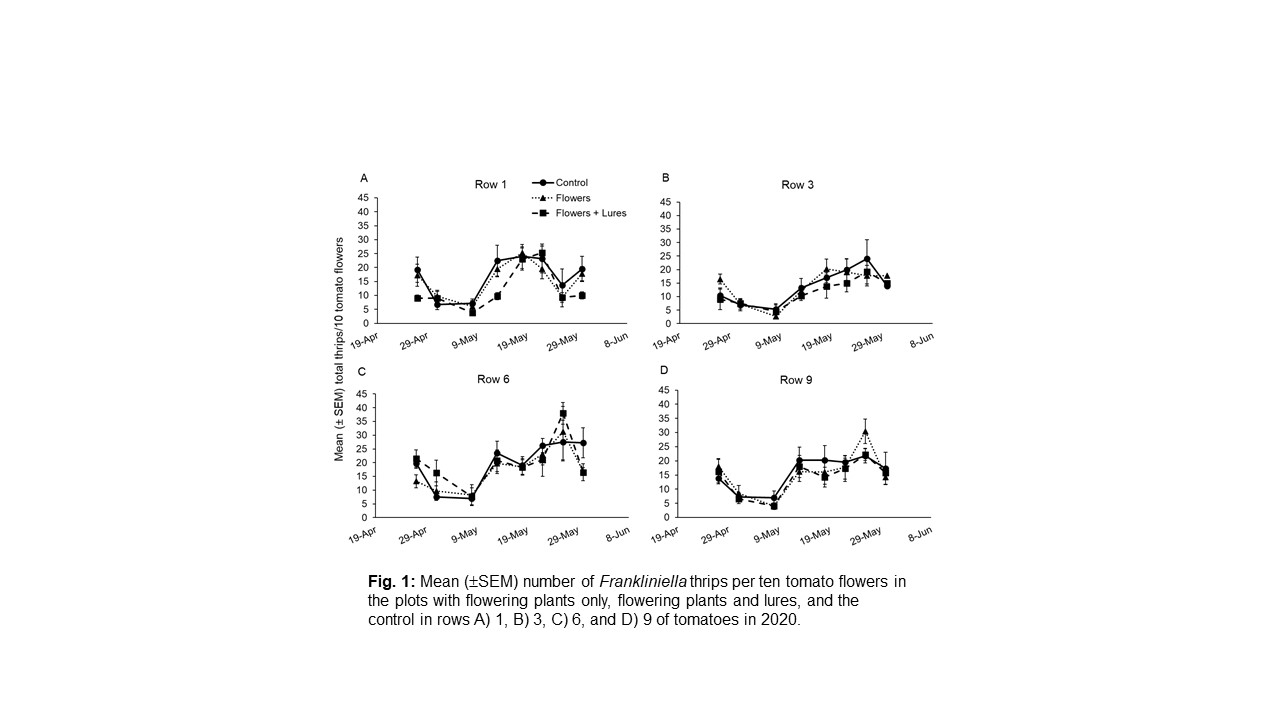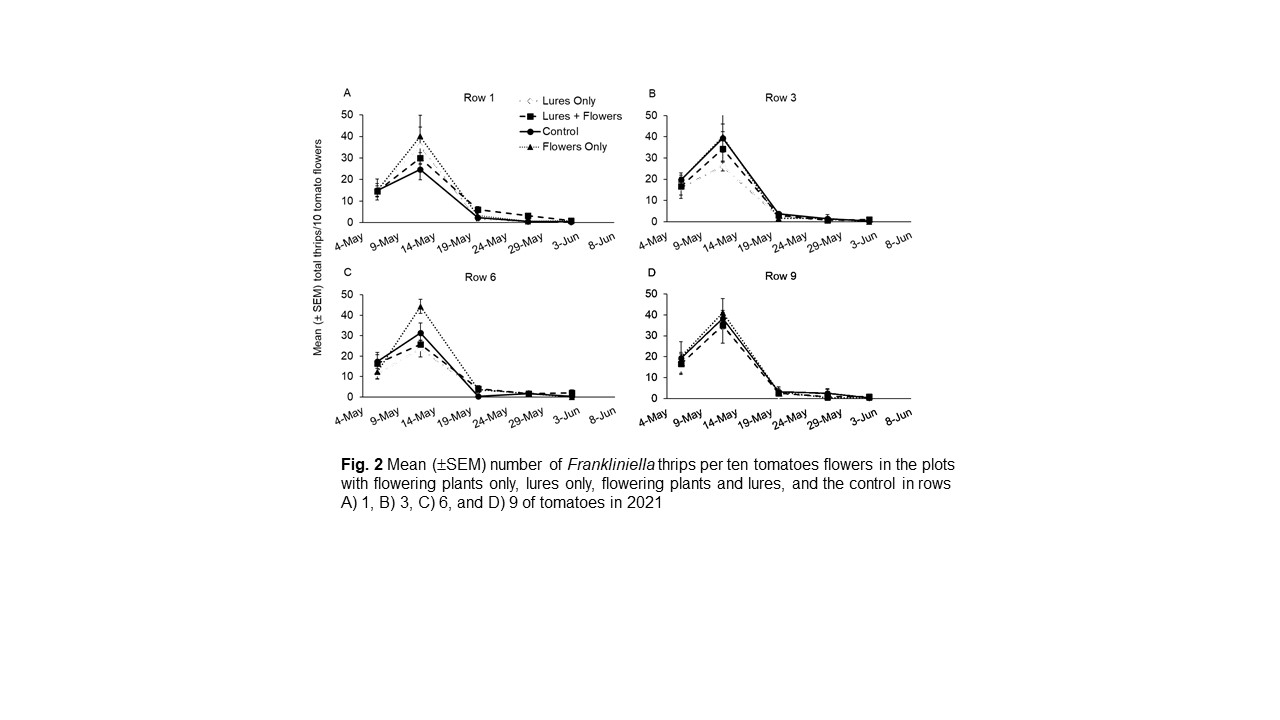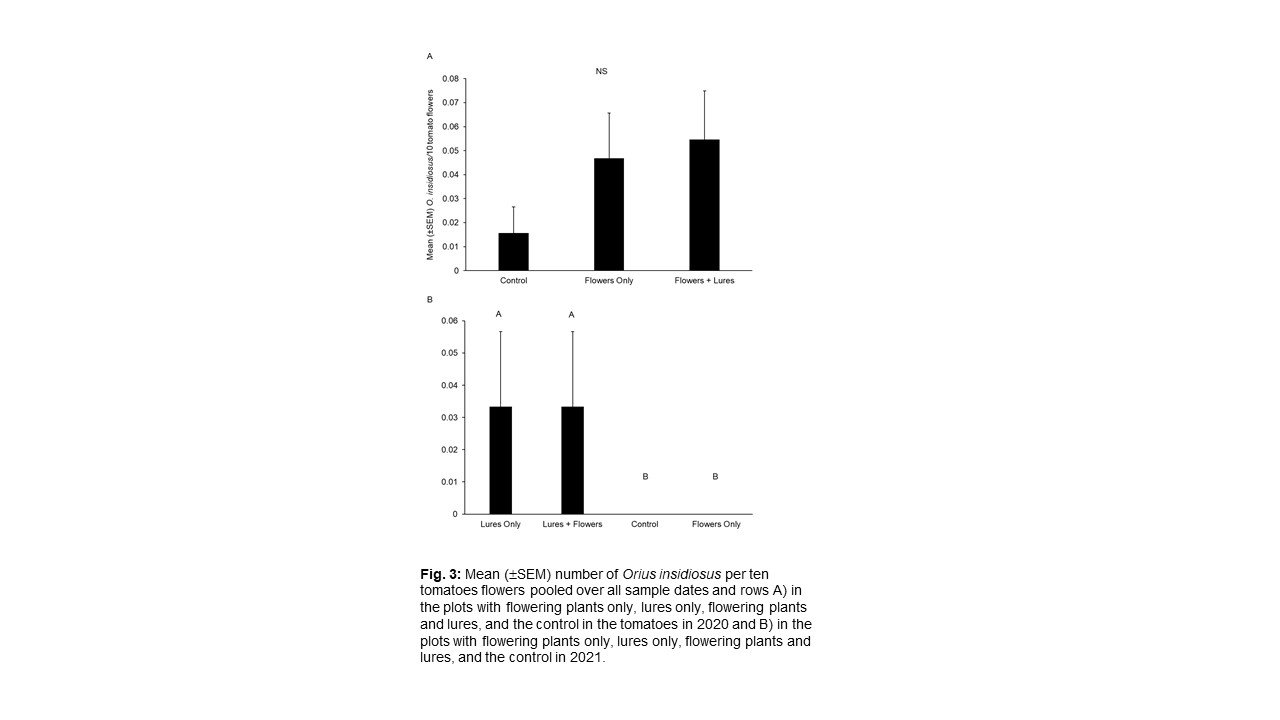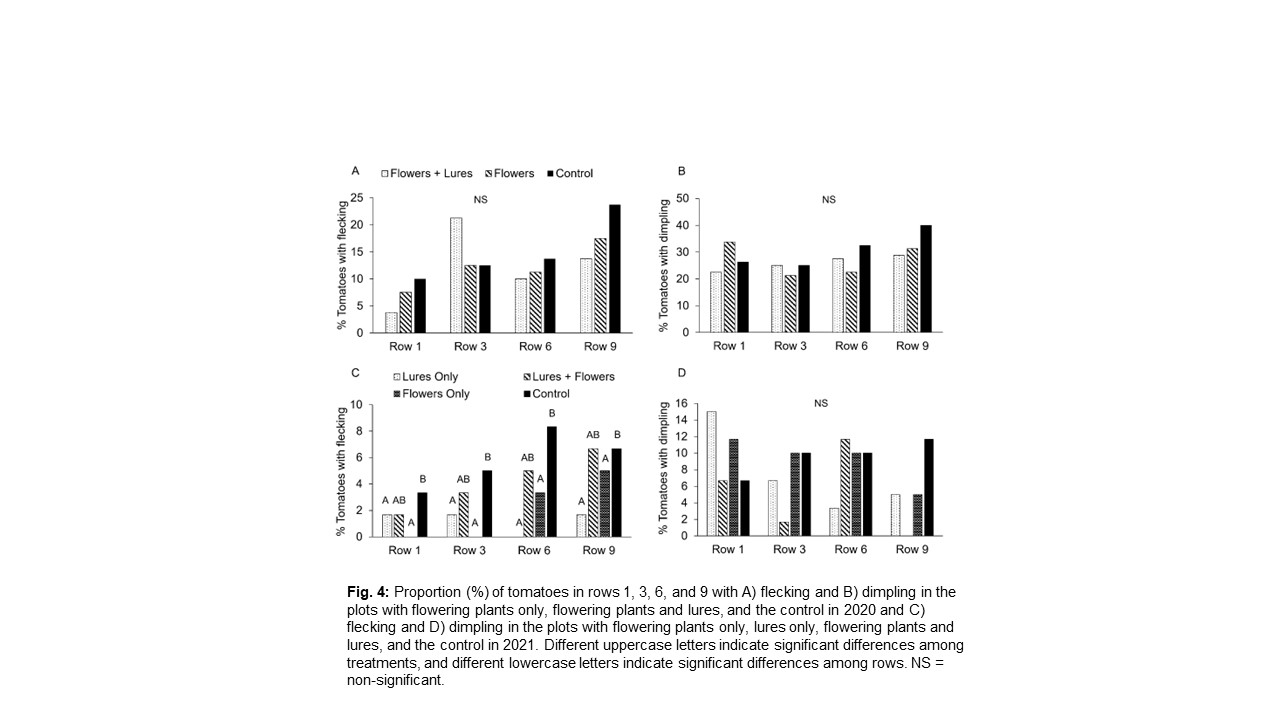Final report for OS20-137
Project Information
In recent years, the effects of semiochemicals on the recruitment of natural enemies into crops from surrounding habitat have gained attention (Simpson et al. 2011). Certain volatiles alert natural enemies to the presence of their host, mates or prey availability (Orre-Gordon et al. 2012). One way to enhance CBC is by combining synthetic volatiles and floral resources to recruit natural enemies (‘attract’) and retain them (‘reward’) (Orre-Gordon et al. 2012), thus exploiting predator prey interactions.
Predatory insects often use sex or aggregation pheromones, both of conspecifics or of their prey, making the identification, synthesis, and use of pheromones to manipulate natural enemies an exciting and potential key to CBC in pest management (Wermelinger 2004). During foraging, minute pirate bugs often exploit cues associated with prey (Aldrich 2007). For example, one species of minute pirate bug, O. tristicolor (White), was observed to do intensive searching in the presence of the alarm pheromone (decyl and dodecyl acetates) of F. occidentalis. The effects of the alarm pheromone on foraging behavior indicated that it may act as an arresting agent, which has potential to increase retention of predators (Teerling 1993).
Previously, Aldrich et al. (2007) identified the sex pheromone of O. insidiosus, which consists of the female-specific compound, (E)-2,7-octadienal, and a compound emitted by both sexes, (E)-2-octenal. The (E)-2-octenal is a trail pheromone deposited by O. insidiosus as walk, which stimulates conspecific adults to search the area. Males likely respond to the trail pheromone to locate potential mates. On the other hand, females most likely use the trail pheromone as a cue indicating potential prey in the vicinity.
The long-term goal of this project is to increase CBC of O. insidiosus by utilizing non-crop floral resources and specific individual or blends of semiochemicals (lures) to create a habitat to recruit higher natural enemy populations, promote dispersal into the crop field, and retain natural enemies for enhanced pest management. Although the concept of ‘attract and reward’ has been used for decades, it has not yet been tested in Florida vegetable production. If successful, this strategy could be a vital component of IPM programs not only in tomatoes, but also across many agricultural systems.
Understanding the relationships among these economically important pests, their associated natural enemies, and floral resources can help to reduce pest management costs and improve profitability for growers. By increasing predator density and decreasing the risk of pest outbreaks, the necessity to spray insecticides on crops is reduced, which will benefit non-target insects, including pollinators, and is key to sustainable agriculture. We argue, therefore, that there is a critical need to develop new technologies to move predators from companion plants to the interior of the field crop.
The ‘attract and reward’ strategy will be tested at a tomato grower field in Bainbridge-Decatur County in South Georgia. The experiment will be conducted twice each year (2020 and 2021) as there are two growing seasons, once in the spring and once in the fall. In the fall, whiteflies are the major pest in tomato, whereas thrips are the main pest in the spring. Wildflower species to be used in the flower strips will be purchased as seed. Selection of wildflower species will be based on the following criteria:
- Results from current and previous research in Florida on wildflower plantings near fruit and vegetable crops that are known to support natural enemies, specifically O. insidiosus.
- Consultation with horticulturalists and ornamental specialists, industry personnel, and those participating in the research.
- Characteristics of the flowering plant species that allow for the most efficient mix with respect to environmental conditions, management requirements, and other horticultural properties specific to this region.
Based on previous studies and consultations with horticulturalists, flowering plant species to be used in the hedgerow will be tested for compatibility with the tomato growing season. Currently, the following three flowering plant species have been selected: Bidens alba, Coreopsis leavenworthii, and Trifolium. pratense. All flowering plants will be started in a greenhouse prior to the planting season for tomatoes.
The lures will consist of the alarm pheromone of F. occidentalis (decyl acetate plus dodecyl acetate) and a blend of the trail pheromone of O. insidiosus ((E)-2-octenal) plus the female sex pheromone of O. insidiosus, (E)-2,7-octadienal, will be used as the attractive lures. The alarm pheromone of F. occidentalis and the trail pheromone of O. insidiosus are commercially available and will be purchased. The female sex pheromone of O. insidiosus will be synthesized based on a protocol published by Aldrich et al. (2007). The attractant blend will be placed in polyethylene containers. Semiochemicals will be released by diffusion using 0.6 mL polyethylene BEEM vials. A 1:1 solution will be diluted in mineral oil, and 200 µL of the solution will be pipetted into each vial. The vial lid will be punctured with a 1 mm hole in order to obtain an average release rate of approximately 10 mg/day.
A split plot design will be established where flower strips will be planted concurrently along one border of the crop, in the same raised-bed structure as the crop. The following treatments will be applied: 1) no flowering plants, no attractant (untreated control), 2) flowering plants without attractant, 3) no flowering plants with attractant, and 4) flowering plants with attractant. Attractive lures will be placed in the 1st, 3rd, 6th, and 9th rows of tomatoes in plots with attractants and will be replaced weekly. There will be four replicated plots per treatment. Fields will be managed in accordance with the grower’s production standards, but no pesticides will be applied to the hedgerows. If necessary, after planting, hedgerows will be irrigated, fertilized, and weeded.
Ten tomato flowers from each plot will be collected at each distance from the hedgerow once tomatoes begin to flower, following the protocol established by Funderburk et al. (2019). Flower samples will be stored in vials containing 70% ethanol. Flower thrips adults and larvae and O. insidiosus adults and nymphs will be counted in the laboratory. Flower thrips adults will be identified to species.
The number of whitefly adults and nymphs will be counted every week on the underside of three fully expanded leaves of 10 randomly selected tomato plants at each distance from the hedgerow. Whitefly nymphs will be counted on a 2 cm diameter leaf circle from 10 randomly selected plants at each distance from the hedgerow. Tomatoes will be harvested from each plot to determine any differences in yield and quality among treatments. Fruits will be graded according to standard USDA grading procedures.
Data are expected to be Poisson distributed. Therefore number of flower thrips, whiteflies, and O. insidiosus, as well as the yield will be compared across treatments with generalized linear mixed model with Poisson distribution. The effect will not be considered significant when >0.050. A post-hoc Tukey test will be performed to determine differences in means among treatments.
Cooperators
- (Researcher)
- - Producer
Research
The research was conducted on a conventional tomato crop located in North Florida in Gadsden county in fall 2020 and fall 2021. To test the effect of combining semiochemical attractants with flower resources a split-plot design was established where hedgerows of flowering plants were planted along one border of the crop, in the same raised-bed structure as the crop. The following treatments were applied: 1) no flowering plants, no attractant (untreated control), 2) flowering plants without attractant, and 4) flowering plants with attractant. Attractive lures were placed in the first, third, sixth, and ninth rows of tomatoes in plots with attractants and were replaced weekly.
Spanish needle (Bidens alba) and Coreopsis leavenworthii were selected as companion plants as they do not host western flower thrips and flowering occurs concomitantly with tomato crops. All flowering plants were started in a greenhouse before the planting season for tomatoes.
The lures consisted of the female sex pheromone of O. insidiosus, (E)-2,7-octadienal. Semiochemicals were released by diffusion using 0.6 mL polyethylene vials. A 1:1 solution was diluted in mineral oil, and 200 µL of the solution will be pipetted into each vial. The vial lid was punctured with a 1 mm hole to obtain an average release rate of approximately 10 mg/day.
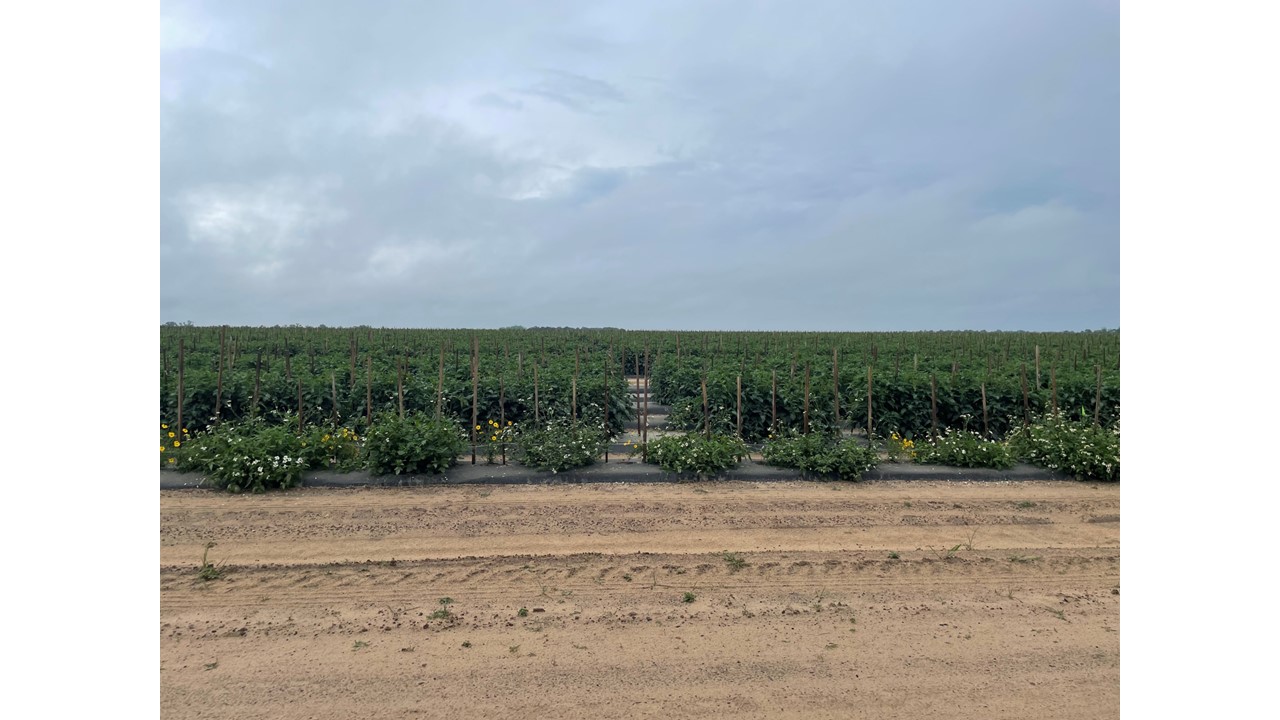
Ten tomato flowers from each plot were collected at each distance from the hedgerow once the tomatoes began to flower. Flower samples were stored in vials containing 70% ethanol. Flower thrips adults, larvae, and O. insidiosus adults and nymphs were counted in the laboratory. Flower thrips adults were identified to species.
Western flower thrips were the dominant thrips species in tomato flowers, whereas Frankliniella tritici, the eastern flower thrips that are not pests of tomato were dominant in Spanish needles and Coreopsis. In 2021, there was a slight but significant decrease in the number of thrips found in the plots with the semiochemical lures and flowers compared to those without the lures, but not in 2020 (Fig. 1 and 2).
Overall, few Orius were found in tomatoes; however, in both 2020 and 2021 there were higher numbers of O. insidiosus found in the plots with flowering plants compared to the control (fig. 3).
In 2020 there were no differences in tomato yield among treatments and there was no difference in the amount of flecking or dimpling on tomatoes among treatments or rows. In 2021 while the yield was similar across treatments there was significantly more flecking on tomatoes in the control plots compared to those with lures only and flowers only (fig. 4).
Educational & Outreach Activities
Participation summary:
We organized a field day on October 21, 2021 at the UF/IFAS center in Citra, FL on sustainable agriculture, the results of this study were presented. We had 40 attendees, with 33% of attendees indicate potential change in behavior with planting companion plants along the tomato grove to increase natural enemies densities.
One article has been published from this study:
- Strzyzewski I, Funderburk J., Martini X. (2023) Specificity of vectoring and non-vectoring flower thrips species to pathogen-induced plant volatiles. Journal of Pest Science. In press
One has been submitted, and the other is in preparation:
- Strzyzewski I., Martini X. Importance of wildflower pollen in Orius insidiosus diet. Submitted to Florida Entomologist.
- Strzyzewski I, Funderburk J, Freeman J, Martini X. Development of an attract and reward strategy to manage western flower thrips in pepper. To be submitted in Crop Protection.
We published the three following Extension articles where data from our research are included:
- Martini X, Funderburk J. (2020) Management of thrips in tomatoes. VSC News. 3: 8-9
- Martini X, Funderburk JE, Webb SE, Smith HA. (2021) Arthropod management for tomatoes, peppers, and eggplants. EDIS UF/IFAS Extension. #IN169, rev 3/2021 (4). doi.org/10.32473/edis-in169-2020
- Smith HA, Capinera JL, Martini X. (2021) Natural enemies and Biological Control. EDIS UF/IFAS Extension. #IN120, rev 3/2021 (3). doi.org/10.32473/edis-in1201-2018
This is the three Online trainings from this project:
- Martini X. Workshop. Updates on vegetable and citrus pest control in Florida. IFAS Certified Crop Adviser. April 2021. Online recorded talk. 100 attendees.
- Martini X, Funderburk J. Workshop. Thrips control for peppers and tomatoes. Great Lake Fruit, Vegetable and Farm Expo. Online meeting. December 8, 2020. 110 attendees.
- Martini X, Funderburk J. Workshop. Asian bean thrips control. Online meeting. Sept. 9, 2020. 52 attendees.
This is the four webinars, talks and presentations from this project:
- Martini X. Workshop. Advances in insect control. Gadsden County Tomato Producers Forum. Quincy, FL. Dec. 8, 2022. 50 attendees.
- Strzyzewski I, Martini X, Funderburk J. Symposium. Investigation of responses of flower thrips and Orius insidiosus to TSWV and TYLCV-induced volatiles in tomatoes. Annual Meeting of the Entomological Society of America. Online meeting. November 11- 24 2020.
- Strzyzewski I, Funderburck J, Martini X. Development of an attract and reward strategy for predators of flower thrips in Florida fruiting vegetables. Annual meeting of the Entomological Society of America. Denver, CO. Oct. 31 - Nov. 3, 2021.
- Strzyzewski I, Martini X. Specificity of pathogen-induced plant volatiles from two viruses to vectoring and non-vectoring species of flower thrips. International Congress of Entomology. Helsinki, Finland. July 17-22, 2022.
Learning Outcomes
We reported that some growers plant companion plants along the border of the field to increase natural enemies. Since 2020, Craig Frey (Extension Director from Hendry County Florida) recommends refuge crops (sunflower, coreopsis and Bidens alba) to attract Orius and keep thrips population in check instead of conducting preventive insecticide spray.
Spanish needles (Bidens alba) are not considered anymore as weed by some growers, some try to maintain a population of Spanish needles to increase natural enemies and support pollinator population.
